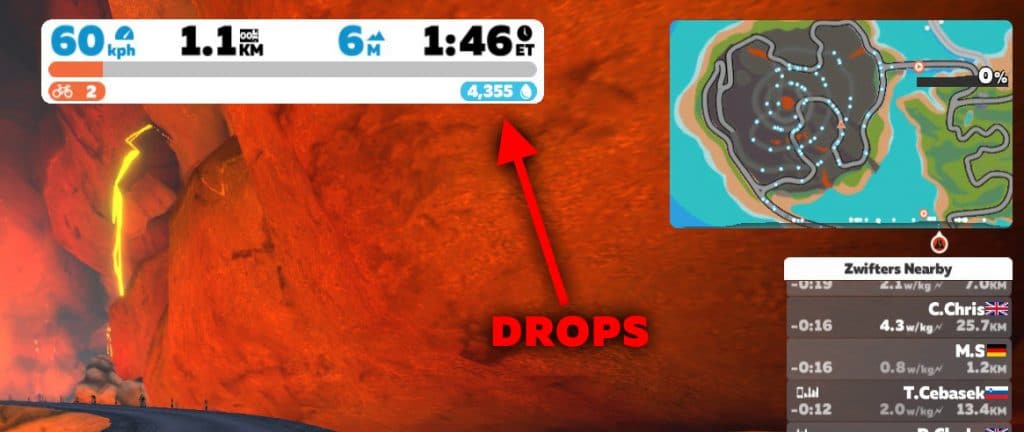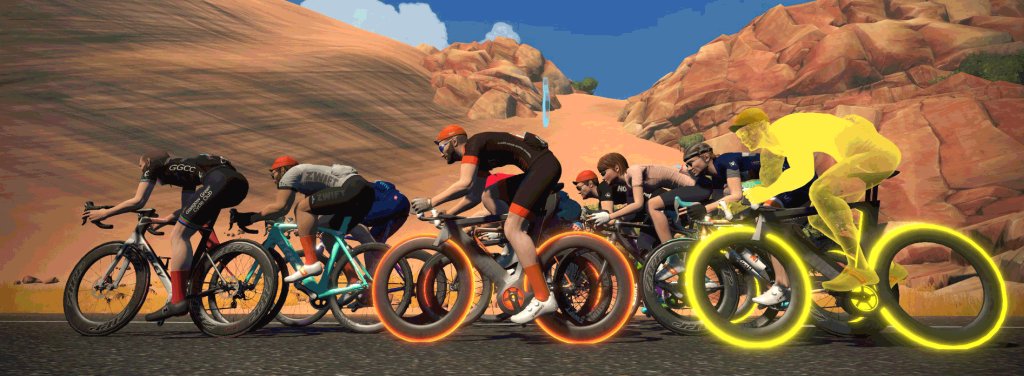Drops are Zwift’s virtual currency, introduced to the game when Zwift released the Drop Shop in February 2019. Use them to purchase virtual equipment like bike frames and wheels for your Zwift garage.
So how do Drops work? Or more specifically: how do we get them, and how can we get them faster?
First, the Basics
A Drop is roughly equal to 1 US cent. So a $10,000US bike frame will cost roughly 1,000,000 Drops, while a $1500US wheelset will cost 150,000 Drops. Zwift obviously included some other factors when setting Drop Shop prices, but 1 Drop equalling 1 cent is a good way to understand pricing.
You can see Drops adding up as you ride or run, just beneath your ride timer:

Drops are based on your effort (drops of sweat, get it?) – if you aren’t working, you aren’t earning.
Take a Drops Deep Dive
The specifics of how Drops are rewarded aren’t known (Zwift isn’t sharing the formula), but we can draw some conclusions based on what we do know and what we see in tests.
We know there are six factors affecting your “Drop rate” (how quickly you receive Drops):
- Calories burned: this is the main factor
- Your Gender: yep, it matters!
- Elevation: more incline=more Drops
- Distance: more distance=more Drops
- Receiving Ride Ons: the easiest way to boost your Drop rate
- Drops Multiplier Game: sticking close to a Pace Partner increases your Drops rate
(Apart from steadily earning Drops as you ride around, bonus chunks of Drops are given out as a reward in various situations. For example, you will receive 50,000 Drops each time you level up. You’ll also get bonus Drops if the Alpe du Zwift prize spinner lands on a prize you already own.)
Let’s dig into each of the six “Drop rate factors” a bit more…
Calories Burned
Your rate of calorie burn can be easily calculated based on your current power output. Zwift is constantly adjusting your Drop rate based on your watts. This makes sense, of course: it’s your power levels that determine how much “work” you are actually doing. While there are other factors that figure into the overall Drop rate equation, power to your pedals is the #1 driver.
Want to learn more about how calorie burn relates to wattage? Read this post.
Your Gender
This may be controversial for some, but here it is: Zwift awards female riders 10% more Drops than male riders for the same effort.
If that seems unfair, consider this: it is well-documented that there are performance differences (in watts) between male and female cyclists. One study comparing men and women under identical race conditions found that men averaged 278 watts in the criterium stage while women averaged 205 watts. This popular power ranking table assumes differences as well. (Many other studies show similar results. Google is your friend if you’re curious.)
Without Zwift building in some gender bias, females on average simply would not be able to accumulate Drops at the same rate as males. So Zwift has added this “gender bias” as a way to equalize things a bit.
I think it’s a good move. It’s not perfect, and we all know this is a complicated issue. But it shows Zwift is thinking about gender issues and trying to be fair to everyone.
Elevation
How much does elevation factor into your Drop rate? It’s significant. Our tests up the Alpe with a male holding 300 watts for 1 minute showed he received around 770 Drops on a gradient averaging ~9%.
Hold that same power for 1 minute on flat ground and the same rider receives around 470 Drops.
So climbing increased our Drops rate by 63%. Interesting. Zwift is certainly giving people an incentive to climb.
Distance
This is an interesting factor to consider, and I believe it is another attempt by Zwift to equalize the playing field a bit, as well as encourage more climbing. Let’s look at the effect of the distance factor a bit more…
Equalizing the Playing Field
Let’s look at two riders, Tiny and Biggz. Tiny weighs 50kg, while Biggz weighs 75kg. Both riders are well-trained cyclists at the same fitness level. Both go out for an all-out hourlong race against each other. Who wins?
The answer depends on the course, of course. Just like in pro cycling, Tiny will win if the course has a lot of climbing, because he’s got the power-to-weight ratio to drop Biggz up hills. Biggz will win if it’s a flat course, because his higher watts can make Tiny suffer.
(Obviously, I’m making a lot of assumptions here, but hang with me.)
Larger riders can burn more calories than smaller riders because they’ve got more muscle working to produce power. In a purely calorie-based system, larger riders would have the advantage–big folks would earn more, and the little man would be in the virtual poorhouse.
But the little man rides farther at the same wattage as the big man, because he’s got less weight to move. Tiny may also be shorter, which would mean he would travel further than Biggz at the same wattage since height affects speed.
And this is the equalizer. If Tiny and Biggz both hold, say, 200 watts for an hour on the same course, Tiny will earn more Drops because Tiny will ride further.
In our tests, a 75kg rider starting from a dead stop then holding 300 watts for 1 minute earns around 457 Drops. A 50kg rider doing the same earns around 484 Drops–a 6% increase.
Encouraging Climbing
The distance factor also encourages climbing, as your Drop rate will increase on descents (as long as you are still working!) In our tests, a 75k rider holding 300 watts down the Alpe accumulated around 700 Drops per minute… not far off the Drop rate up the Alpe, and much higher than the Drop rate on flat ground.
Receiving Ride Ons
When you receive a Ride On, your Drop rate doubles for 15 seconds. Receive a Ride on while climbing a steep hill and you’ll really earn those Drops quickly!
This is a stellar idea from Zwift because it encourages us to encourage others. I like throwing out random Ride Ons and knowing that it’s putting some virtual money into Zwifters’ pockets.
Drops Multiplier Game

Zwift rolled out a Drops Multiplier “game” with its Robopacers feature. Basically, the longer you ride near a Robopacer, the higher your Drops multiplier increase, from 1.2x all the way up to 2.5x! This can provide a huge boost in Drops accumulation. Read all about the Drops Multiplier Game here >
How Quickly Do Drops Accumulate?
Quite quickly, really. In a recent 90 minute workout on the Road to Sky route I earned just over 58,000 Drops with an average power of 228 watts for the ride. This calculates out to an hourly Drop rate of around 39,000.
If I ride at that pace for an hour every day of the week I’ll earn ~270,000 Drops weekly, or over 14 million Drops annually.
If you receive a fair number of Ride Ons from friends, ride with Robopacers, and push hard (high watts) you can get over 60,000 Drops per hour, which would work out to 420,000 Drops weekly, or almost 22 million Drops annually!
How Do You Get The Most Drops?
Considering all these factors and our tests to date, the fastest way to get Drops is:
- Climb. A lot.
- Make friends who like to give Ride Ons.
- Ride with a Robopacer to receive a Drops Multiplier
- Go hard.
Your Thoughts
I would love to hear your questions and comments on Drops. Do they help motivate you? Does the calculation scheme seem sensible? Chime in below.
